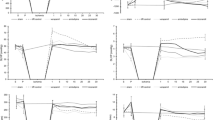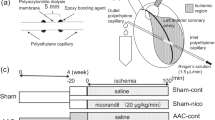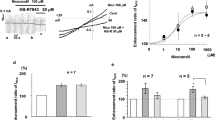Abstract
We examined whether nisoldipine, a calcium (Ca) channel blocker, increases coronary blood flow (CBF) without decreasing aortic blood pressure (AoP) with ischemic and nonischemic hearts, and whether the presence of cellular acidosis in ischemic myocardium contributes to the augmentation of coronary vasodilation due to nisoldipine. In 42 dogs, coronary perfusion pressure (CPP) was reduced so that CBF decreased to 60% of the baseline, and CPP was maintained constant thereafter. First, we administered nisoldipine into a systemic vein in the ischemic and nonischemic hearts. Second, nisoldipine was administered into the canine coronary artery of the ischemic myocardium with and without administration of either sodium bicarbonate (NaHCO3), sodium hydroxide (NaOH), or amiloride. Nisoldipine (0.25–4.0 mg/kg, IV) increased CBF by 59% in the ischemic myocardium more than the nonischemic myocardium (by 34%) without reducing AoP. The infusion of nisoldipine (40 ng/kg/min, IC) increased CBF markedly by about 55% in the ischemic myocardium with increases in fractional shortening (FS; 11 ± 2% to 21 ± 2%) and lactate extraction ratio (LER; −19 ± 4% to 15 ± 2%). Increases in CBF, FS, and LER were markedly attenuated during administration of nisoldipine with concomitant administration of either NaHCO3 or NaOH. Furthermore, the extent of increases in CBF (54 ± 2 mL/100 g/min), FS (13 ± 2%), and LER (−17 ± 4%) were also markedly attenuated due to the concomitant treatment with amiloride. We conclude that myocardial cellular acidosis plays an important role in mediating coronary vasodilation affected by nisoldipine in the ischemic myocardium. H+ may modulate the property of voltage-dependent Ca channels via Na+–H+ exchange.
Similar content being viewed by others
References
Baumgart D, Ehring T, Heusch G. A proischaemic action of nisoldipine: Relationship to a decrease in perfusion pressure and comparison to dipyridamole. Cardiovas Res 1993;27:1254-1259
Bergmeyer HU. Methods of Enzymatic Analysis, 1st ed. New York: Academic Press, 1963:266-270.
Blatter LA, McGuigan JA. Intracellular pH regulation in ferret ventricular muscle: The role of Na+-H+ exchange and the influence of metabolic substrates. Circ Res 1991;68: 150-161.
Braunwald E, Kloner RA. The stunned myocardium: Prolonged, postischemic ventricular dysfunction. Circulation 1982;66:1146-1149.
Bruneil C, Parodi O, Sambucrti G, et al. Perfusional and metabolic effects of nisoldipine as shown by positron emission tomography after acute myocardial infarction. Am J Cardiol 1995;75:31-35.
Drimal J. Regulation of 1,4-dihydropyridine and beta-adrenergic receptor sites in coronary artery smooth muscle membranes. Cell Signal 1991;3:225-232.
Duncker DJ, Hartog JM, Hugenholtz PG, Saxena PR, Verdouw PD. The effects of nisoldipine (Bay K 5552) on cardiovascular performance and regional blood flow in pentobarbital-anesthetized pigs with or without β-adrenoceptor blockade. Br J Pharmacol 1986;88:9-18.
Duncker DJ, Saxena PR, Verdouw PD. The effects of nisoldipine alone and in combination with beta-adrenoceptor blockade on systemic haemodynamic and myocardial performance in conscious pigs. Eur Heart J 1987;8:1332-1339.
Duncker DJ, Heiligers JPC, Saxena PR, Verdouw PD. Nisoldipine and perfusion of post-stenotic myocardium in conscious pigs with different degrees of concentric stenosis. Br J Pharmacol 1988;94:219-227.
Ehring T, Heusch G. Stunned myocardium and the attenuation of stunning by calcium antagonists. Am J Cardiol 1995;75:61-67.
Godfraind T, Egleme C, Finet M, Debande B, Jaumin P. Comparison of nifedipine and nisoldipine on human arteries and human cardiac tissues in vitro. In: Hugenholtz, PG, Meyer, H, eds. Nisoldipine. Berlin: Springer-verlag, 1987: 36-44.
Heusch G. Ischemia-selectivity: A new concept of cardioprotection by calcium antagonists. Basic Res Cardiol 1994;89:2-5.
Kaibara M, Kameyama M. Inhibition of the calcium channel by intracellular protons in single ventricular myocytes of the guinea-pig. J Physiol 1988;403:621-640.
Kaibara M, Mitarai S, Yano K, Kameyama M. Involvement of Na+-H+ antiporter in regulation of L-type Ca2+ channel current by angiotensin II in rabbit ventricular myocytes. Circ Res 1994;75:1121-1125.
Kitakaze M, Hori M, Iwakura K, et al. α-Aderenoceptor activity regulates release of adenosine from the ischemic myocardium in dogs. Circ Res 1987;60:631-639.
Kloner RA. Nifedipine in ischemic heart disease. Circulation 1995;92:1074-1078.
Manders WT, Vatner SF. Effects of sodium pentobarbital anesthesia on left ventricular function and distribution of cardiac output in dogs, with particular reference to the mechanism for tachycardia. Circ Res 1976;39:512-517.
Menestrina G, Forti S, Gambale F. Interaction of tetanus toxin with lipid vesicles. Effects of pH, surface charge, and transmembrane potential on the kinetics of channel formation. Biophys J 1989;55:393-405.
Mori H, Haruyama S, Shinozaki Y, et al. New nonradioactive microspheres and more sensitive X-ray fluorescence to measure regional blood flow. Am J Physiol 1992;263: H1946-H1957.
Opie LH. Calcium channel antagonists: Part VI: Clinical pharmacokinetics of first and second-generation antagonists. In: Opie LH, ed. Clinical Use of Calcium Channel Antagonist Drugs. Dordrecht, Holland: Kluwer Academic, 1990:245-279.
Opie LH. Should calcium antagonists be used after myocardial infarction? Ischemia selectivity versus vascular selectivity. Cardiovasc Drugs Ther 1992;6:19-24.
Opie LH. The ever expanding spectrum of ischemic left ventricular dysfunction. Cardiovasc Drugs Ther 1994; 8:297-304.
Park SW, Tang XL, Qiu Y, Sun JZ, Bolli R. Nisoldipine attenuates myocardial stunning induced by multiple coronary occlusions in conscious pigs and this effect is independent of changes in hemodynamics or coronary blood flow. J Mol Cell Cardiol 1996;28:655-666
Pozo MA, Gallego R, Gallar J, Belmonte C. Blockade by calcium antagonists of chemical excitation and sensitization of polymodal nociceptors in the cat's cornea. J Physiol 1992;450:179-189.
Salim Y. Calcium antagonists in coronary artery disease and hypertension: Time for reevaluation. Circulation 1995;92: 1079-1082.
Sheiban I, Tonni S, Marini A, Trevi G. Clinical and therapeutic implications of chronic left ventricular dysfunction in coronary artery disease. Am J Cardiol 1995;75:23-30.
Sheiban I, Tonni S, Chizzoni A, Marini A, Trevi G. Recovery of left ventricular function following early reperfusion in acute myocardial infarction: A potential role for the calcium antagonist nisodipine. Cardiovasc Drugs Ther 1997;11:5-16.
Theroux P, Ross J Jr., Franklin D, Covell JW, Bloor CM, Sasayama S. Regional myocardial function and dimension early and after myocardial infarction in the unanesthetized dogs. Circ Res 1997;40:158-165.
The Multicenter Diltiazem Postinfarction Trial Research Group. The effect of diltiazem on mortality and reinfarction after myocardial infarction. N Engl J Med 1988;319:385-392.
The DEFIANT Research Group. Improved diastolic function with the calcium antagonist nisoldipine (coat-core) in patients with post myocardial infarction: Results of the DEFIANT study. Doppler flow and echocardiography in functional insufficiency: Assessment of nisoldipine therapy. Eur Heart J 1992;13:1496-1505.
Warltier DC, Meils CA, Gross GJ, Brooks HL. Blood flow in normal and acutely ischemic myocardium after verapamil, diltiazem and nisoldipine (Bay K 5552), a new dihydropyridine calcium antagonist. J Pharmacol Exp Ther 1981; 218:296-302.
Warltier DC, Zyvoloski MG, Gross GJ, Brooks HL. Comparative actions of dihydropyridine slow channels calcium blocking agents in conscious dogs: Systemic and coronary hemodynamics with and without combined beta adrenergic blockade. J Pharmacol Exp Ther 1984;230:367-385.
Warltier DC, Zyvoloski MG, Gross GJ, Brooks HL. Comparative actions of dihydropyridine slow channels calcium blocking agents in conscious dogs: Alterations in baroreflex sensitivity. J Pharmacol Exp Ther 1984;230:376-382.
Watts JA, Hawes EM, Jenkins SH, Williams TC. Effects of nisoldipine upon the “no reflow” phenomenon in globally ischemic rat hearts. J Cardiovasc Pharmacol 1990;16: 487-494.
Author information
Authors and Affiliations
Rights and permissions
About this article
Cite this article
Kitakaze, M., Funaya, H., Komamura, K. et al. Nisoldipine Selectively Induces Coronary Vasodilation and Improves Mild Myocardial Ischemia in Dogs: A Potential Role of Cellular Acidosis. Cardiovasc Drugs Ther 12, 533–541 (1998). https://doi.org/10.1023/A:1007714718298
Issue Date:
DOI: https://doi.org/10.1023/A:1007714718298




